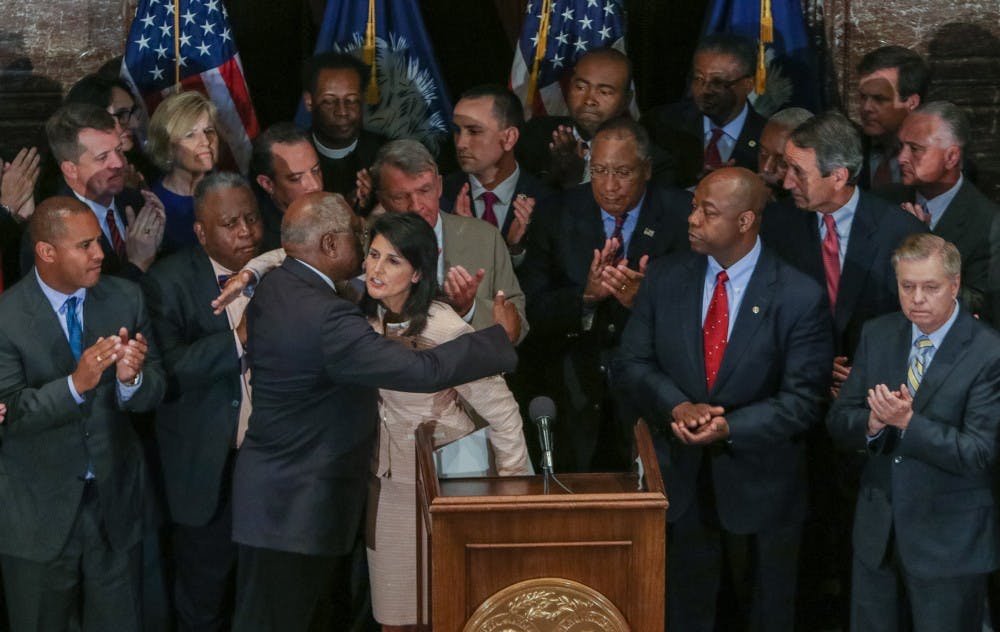ATLANTA (AP) — Tributes to the Confederacy and the Jim Crow era that have existed still abound in the Deep South and beyond more than a century after the end of the Civil War.
Here are some of the most high-profile displays, including several that are being criticized anew following the fatal shooting of nine parishioners at a historic black church in Charleston, South Carolina:
ALABAMA: An 88 -foot-tall Confederate memorial sits at the Capitol entrance nearest the governor's office. It features four different Confederate banners, including the battle flag. Jefferson Davis, the lone president of the Confederacy, is said to have laid the cornerstone at a ceremony in 1886. Two nearby public high schools, now with nearly all-black student bodies, are named for Davis and Robert E. Lee, commander of the Confederateforces.
ARKANSAS: There are two Confederate monuments on the Capitol grounds, one honoring Confederate women, the other soldiers.
FLORIDA: No confederate flag flies at the Florida Capitol, but the state flag, whose main design was adopted in 1900, features a St. Andrew's Cross — an 'X' emblazoned across the banner. The imagery is similar to the BattleFlag, though it also reflects a flag of the Spanish empire when it ruled Florida from the early 16th century until 1763. Several county courthouses and local public squares or parks feature Confederate veterans monuments.
GEORGIA: The Capitol and surrounding grounds feature multiple statues, busts and portraits of Confederatewar heroes and segregationist politicians. In the Capitol rotunda is a portrait of Alexander H. Stephens, vice president of the Confederacy. A bust of Stephens sits just outside the rotunda. The Georgia state flag, a compromise version that replaced a design with the battle flag, is modeled after the "Stars and Bars," the first national flag of the Confederacy. Twenty miles from the Capitol is Stone Mountain, which features a massive carving of Jefferson Davis, Stonewall Jackson and Robert E. Lee, all on horseback.
KENTUCKY: Jefferson Davis is among the statues included in the Capitol rotunda. The Davis statue is situated behind the Abraham Lincoln statute that sits in the rotunda's center, so that the president of the Confederacy appears to be looking over the shoulder of the 16th U.S. president who governed during the Civil War.
LOUISIANA: A statue of Robert E. Lee sits at the center of Lee Circle, a major traffic circle connecting downtown New Orleans to the Garden District neighborhood. Another city thoroughfare is named for Jefferson Davis and includes a statue of the Confederate president.
MISSISSIPPI: The state flag is the last U.S. state banner to include an explicit image of the Confederate battleflag. At one Capitol entrance sits a monument to the women of the Confederacy. The University of Mississippi's athletics teams are knowns as the "Ole Miss Rebels," and the school's band often plays "Dixie" at sporting events.
NORTH CAROLINA: An obelisk memorial to the state's Confederate war dead and a monument to the "North Carolina Women of the Confederacy" are located on the old Capitol grounds in Raleigh. The Capitol square also includes statues of Civil War-era Gov. Zebulon Vance and Gov. Charles Aycock, known partly for his anti-black rhetoric at the end of the 19th century.
SOUTH CAROLINA: The Confederate battle flag flies at the base of a Confederate monument in front of the Capitol. It flies between a Confederate monument and a statue of Benjamin Tillman, a noted white supremacist who spent three decades — from 1890 to 1918 — as governor and U.S. senator. Behind the Capitol is a statue of Strom Thurmond, a long-serving U.S. senator who ran for president in 1948 as a "Dixiecrat" to protest the national Democratic Party's softening stance on segregation.
TENNESSEE: A bust of Nathan Bedford Forrest, an early Grand Wizard of the Ku Klux Klan, is inside the Capitol.
VIRGINIA: Arlington National Cemetery, formerly the plantation of Robert E. Lee, includes a Confederatesection with almost 500 graves surrounding a memorial. Future President William Howard Taft authorized the memorial in 1906, when he served as secretary of war for President Theodore Roosevelt.





